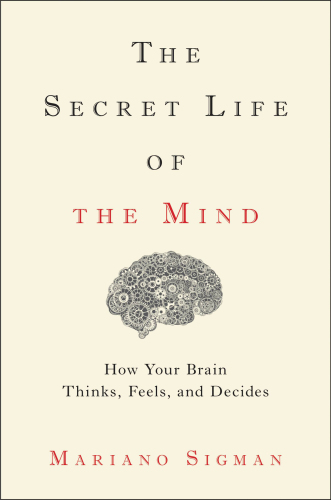
The Secret Life of the Mind
How Your Brain Thinks, Feels, and Decides
- اطلاعات
- نقد و بررسی
- دیدگاه کاربران
نقد و بررسی

April 24, 2017
Hidden, behind-the-scenes mechanics of thought are revealed in this scintillating ramble through brain science. Cognitive neuroscientist Sigman expands his celebrated TED talk to show the unexpected inner workings of a raft of mental phenomena: the sophisticated innate theories of mind and moral philosophy that infants use to parse social life and the complex statistical analyses they deploy to learn language; the subconscious calculations that underlie hunches, which turn out to be surprisingly accurate and which determine our decisions many seconds before we are consciously aware of them; the active mental lives of patients in a “vegetative state”; the genetic endowment of champion athletes, seen less in physical talent than in mental determination and “fighting spirit”; astronomer Carl Sagan’s marijuana epiphanies; and the author’s own mysterious ability to control the temperature of his fingertips. Calling on authors from Plato to Freud and on a trove of cute experiments on brainy babies, some of his own devising, Sigman’s lucid exposition probes and unsettles our intuitions about how we think in the light of new science that makes the machinery transparent. The loosely organized text meanders at times, but readers will find it a fascinating browse packed with arresting insights at every turn. Agent: Max Brockman, Brockman Inc.

May 15, 2017
An exploration of recent discoveries in neuroscience and the ways in which we perceive and interpret the world.The good news is that good news is received and processed in one part of the brain. The bad news is that bad news is received and processed in another region. Why? Sigman, the founder of the Integrative Neuroscience Laboratory at the University of Buenos Aires and director of the Human Brain Project, ventures explanations for this apparent mystery, but more, he enfolds a few lessons on the controversial thesis that optimists and pessimists have different kinds of brains, much as conservatives and liberals are said to be wired differently. The author is an experimentalist with training in physics, supporting these softer interpretations with hard-edged results. One of the most on-point parts of the book is Sigman's discussion of the application of neuroscience to general education. Dyslexia, by the author's account, is more a phonological than a visual problem, leading him to declare, "you cannot read without being able to pronounce," and adding, "the phonological awareness system can be stimulated before reading begins," preparing children for reading with word games and other activities. In the larger sphere, learning a second language in very early childhood helps shatter prejudices, for even then, children discern accents and tend to trust those who sound more like them than linguistic outsiders do. The takeaway is that "revealing and understanding these predispositions can be a tool for changing them." The idea that through its relative plasticity the child brain can be molded for the better is not new, but Sigman's pointed examples of rational (and not so rational) decision-making, consciousness, mental states, and learning ("culture travels like a highly contagious virus") are backed by the latest research. There have been many recent books on the workings of the mind, and while this one doesn't quite stand out with the best of the pack, it rewards readers with many useful insights.
COPYRIGHT(2017) Kirkus Reviews, ALL RIGHTS RESERVED.

Starred review from August 1, 2017
Physicist and neuroscientist Sigman (founder, Integrative Neuroscience Laboratory, Univ. of Buenos Aires, Argentina) here builds on his popular TED Talk "Your Words May Predict Your Future Mental Health." His goal is to help readers understand themselves more deeply. Ideas, dreams, emotions from childhood, consciousness, and learning are major themes in this guide to self-knowledge. The human brain has changed little in 60,000 years. At six months infants theorize and form abstract concepts, making discoveries through play and logic, similar to scientific method. They can infer intentions, desires, kindness and wrongdoing. Two year olds comprehend ownership, and with this text, adults can appreciate their thinking and judgment. Currently, most children engage with more than one language--a mental boon for attention, cognitive development, and social inclusion. Sigman's text alludes to ideas from Jean-Jacques Rousseau's Emile and celebrates the work of cognitive psychologist Jacques Mehler. VERDICT Accessible, enjoyable, and enriching, this work is a boon to lay readers, students, and scientists.--E. James Lieberman, George Washington Univ. Sch. of Medicine, Washington, DC
Copyright 2017 Library Journal, LLC Used with permission.

August 1, 2017
Physicist and neuroscientist Sigman (founder, Integrative Neuroscience Laboratory, Univ. of Buenos Aires, Argentina) here builds on his popular TED Talk "Your Words May Predict Your Future Mental Health." His goal is to help readers understand themselves more deeply. Ideas, dreams, emotions from childhood, consciousness, and learning are major themes in this guide to self-knowledge. The human brain has changed little in 60,000 years. At six months infants theorize and form abstract concepts, making discoveries through play and logic, similar to scientific method. They can infer intentions, desires, kindness and wrongdoing. Two year olds comprehend ownership, and with this text, adults can appreciate their thinking and judgment. Currently, most children engage with more than one language--a mental boon for attention, cognitive development, and social inclusion. Sigman's text alludes to ideas from Jean-Jacques Rousseau's Emile and celebrates the work of cognitive psychologist Jacques Mehler. VERDICT Accessible, enjoyable, and enriching, this work is a boon to lay readers, students, and scientists.--E. James Lieberman, George Washington Univ. Sch. of Medicine, Washington, DC
Copyright 2017 Library Journal, LLC Used with permission.




دیدگاه کاربران